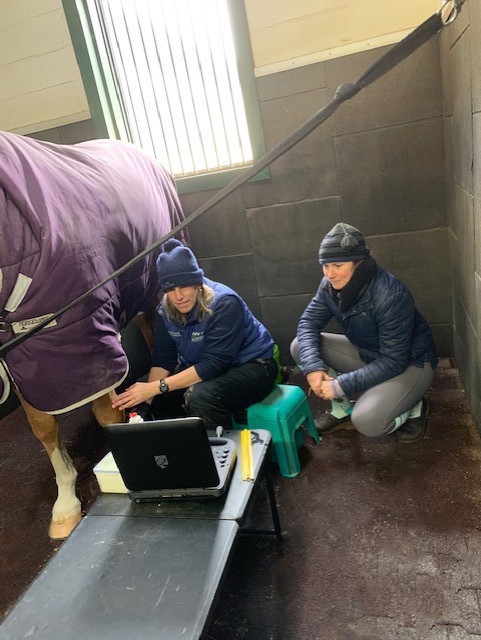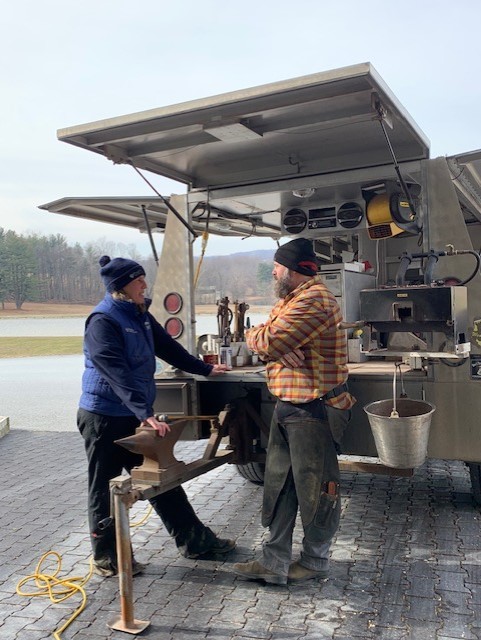

Regardless of the level at which a horse is competing, its veterinary team is at the forefront of most decisions regarding its career and well-being. Liz Arbittier, VMD, CVA, has been working with equine athletes for over two decades. Graduating from the University of Pennsylvania’s School of Veterinary Medicine (Penn Vet) in 2001, she worked in private practice with a focus on sports medicine and pre-purchase exams until joining Penn Vet’s New Bolton Center Field Service team in 2013. Situated in the heart of Area II’s eventing scene, the team provides ambulatory services to the surrounding area, which is home to multiple Olympians.
Dr. Arbittier has worked with all levels of event horses including those competing at the Pan American Games, the World Equestrian Games, and the South American Games. Her long-time focus – whether working with international competitors or starter event ponies – is maintaining the aging athlete and helping riders and trainers to develop annual plans that ensure their equine partners are peaking at optimal moments. In her extensive experience in the field, Dr. Arbittier identifies three essential practices for maximizing horses’ longevity and soundness: routine consultations for early intervention; good home management; and excellent farrier care.
“Catching red flags early is vital,” Dr. Arbittier emphasizes. “It can mean the difference between three weeks off for a mildly irritated tendon and eight months off for a core lesion.” She believes in routine consultations so that issues can be detected early and intervention can begin before severe problems arise.
For the most competitive athletes, monthly evaluations are recommended while an evaluation every three to four months is usually sufficient for the average athlete as long as they are not dealing with a specific issue or injury. These evaluations include a comprehensive exam where she watches a horse jog in-hand and turn in circles on a hard surface and then lunge on a regular ring surface.
“A good rider can make a lame horse sound and a bad rider can make a sound horse lame,” Dr. Arbittier says. “So seeing [a horse] on a circle with no rider tells me a lot.” She then proceeds to watching the horse go under saddle, preferably with its regular rider. “I speak to the rider to see what concerns they have and what is going well,” she says, emphasizing the importance of clear and ongoing communication. “If I see any red flags, or the owner mentions anything that catches my attention, I do a neurological assessment.
Neurological abnormalities can present very similarly to lameness. It’s critical to always look for subtle neurological deficits or you may spend people’s time and money working up a lameness that isn’t actually a lameness!”

A good management program at home is also critical for maintaining soundness and longevity. “I look at everything from nutrition to turnout conditions to health concerns in order to best help my clients maximize their partner’s performance,” says Dr. Arbittier. Ensuring that a horse receives the appropriate nutrients for its level of activity is key. Some of the questions that guide her examination include: “Do they receive enough protein to handle the demands of their schedule with regards to muscle recovery? Are they eating the best type of hay for them?” She emphasizes, also, the importance of monitoring Vitamin E intake. “Even horses who eat lush grass may need supplementation and we know now how critical Vitamin E is to neuromuscular function,” she says.
When it comes to a horse’s fitness program, Dr. Arbittier stresses the importance of considering individual needs. “People like to emulate the fitness programs espoused by top riders, but not every horse will hold up or thrive in that program. One size definitely does not fit all when it comes to a fitness regimen.”
She gives an example of the schoolmaster and his/her specific requirements for optimum well-being and performance. “There is so much to appreciate about them – they are safe, experienced, and know how to make it around a cross-country course while keeping a rider on their back. That said, these horses come with miles, and miles mean wear and tear.” Dr. Arbittier’s passion for ensuring that aging horses can perform at their best while remaining comfortable shines through in her advice for maintenance.
“In my practice area, sore feet at the end of the summer are common, as our ground can bake in July and August. Not only are their feet stinging, but their joints are also aching from concussion. Spending time packing feet and icing legs after a gallop, a jump school on harder footing, or post-competition will help your horse come out better the next time. Plan to give them the day off after a big school or maybe just go for a swinging walk on cushy ground. Don’t over-school them … These horses don’t want to be pounded and you have to determine your goals and assess their physical status to properly set an appropriate exercise regimen. I’ve seen these old campaigners go on for years, and I attribute it to excellent home management.”
Finally, Dr. Arbittier emphasizes the importance of a good farrier. “Pay for the best farrier that you can afford and make their lives as easy as possible,” she advises. “Whether it’s during mud season or at the conclusion of a hot, baking summer, without a great farrier on your team, you won’t be able to keep your horse going.”

With hoof care – as with all other aspects of maintenance – she reiterates the importance of communication.
“Ask your farrier what they may need from the vet to best be able to do their job well. Well-timed radiographs of the feet can be instrumental to deciding what type of shoeing intervention they need.” The respect and empathy that clearly drive Dr. Arbittier’s care of her equine patients extends to her advice on relating to a horse’s care team.
“Don’t complain about your farrier bill, pay on time, and have your horses in and clean when they arrive,” she says. “Do not present your farrier (or vet!) with a mud-covered horse and expect them to clean them up or get filthy underneath them.” In a sport like eventing that relies so heavily on teamwork, the collaboration between owners, riders, farriers, and veterinarians is the foundation of success.
Oliver Townend, who has never made any secret of his desire for another MARS Badminton Horse Trials victory, is now at the head of the leaderboard at the conclusion of the dressage phase.
Are you following along with the action from home this weekend? Or maybe you're competing at an event and need information fast. Either way, we’ve got you covered!
The United States Eventing Association, Inc. (USEA) is excited to head to Area V this Dec. 11-14 for the 2025 USEA Annual Meeting & Convention in the vibrant city of New Orleans, Louisiana! Known for its rich history, world-class jazz, and electrifying Mardi Gras celebrations, New Orleans will set the stage for a lively week of discussion and education on the most important topics in the sport of eventing. Gather your fellow members and meet us to celebrate the last year of success in “The Big Easy!”
The Olympic gold medallists Tom McEwen and JL Dublin lit up the arena at the MARS Badminton Horse Trials with a stunning performance and took the lead after the first day of dressage with the excellent mark of 22.4. They have almost five penalties over second-placed Emily King and Valmy Biats on 27.3.